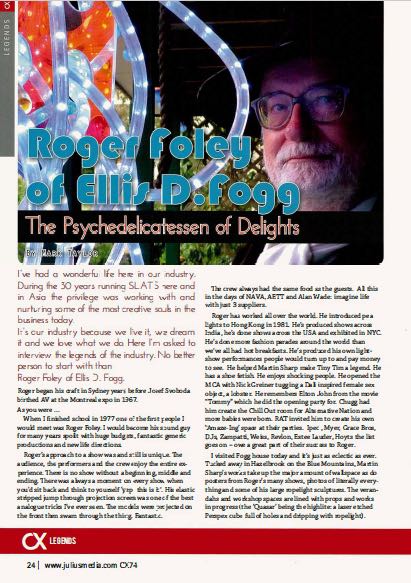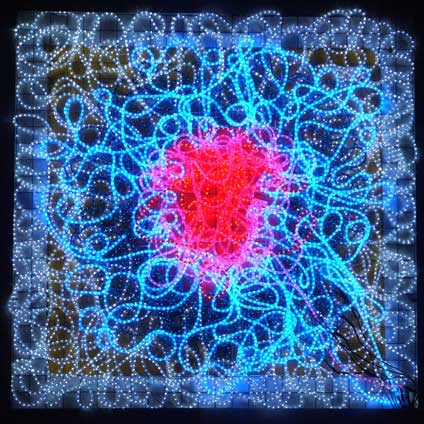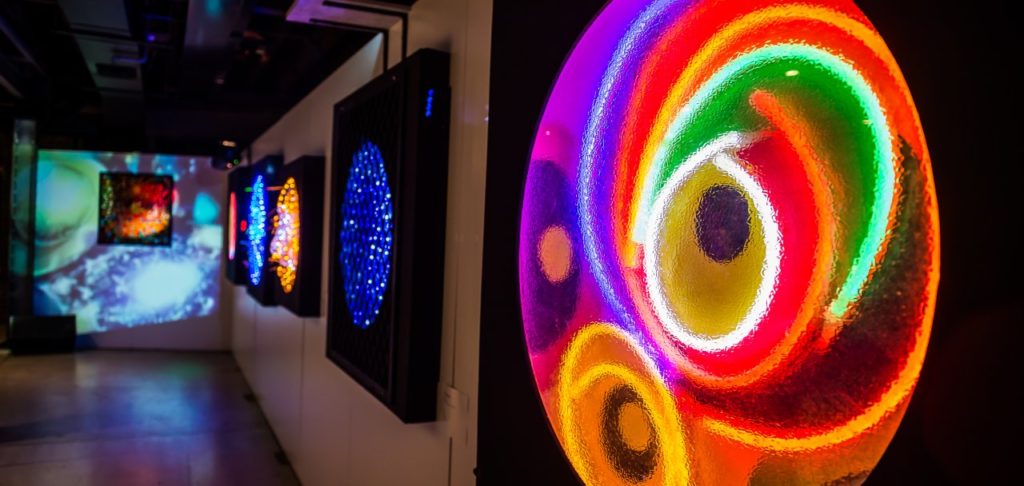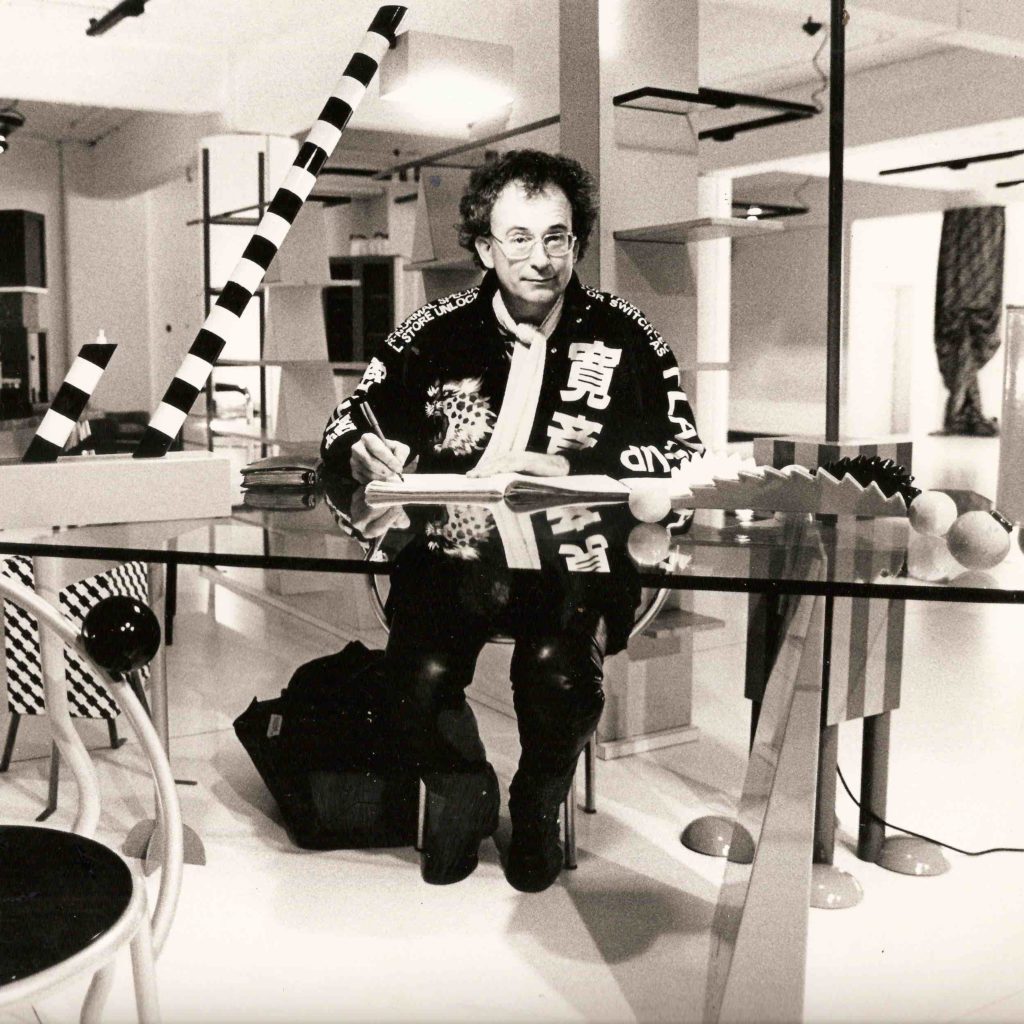History - Lighting
7 Jan 2021
Roger Foley of Ellis D. Fogg

Subscribe to CX E-News
The Psychedelicatessen of Delights
An extract from CX Magazine, September 2012 
I’ve had a wonderful life here in our industry. During the 30 years running SLATS here and in Asia the privilege was working with and nurturing some of the most creative souls in the business today. It’s our industry because we live it, we dream it and we love what we do. Here I’m asked to interview the legends of the industry. No better person to start with than Roger Foley of Ellis D. Fogg.
Roger began his craft in Sydney years before Josef Svoboda birthed AV at the Montreal expo in 1967. As you were … When I finished school in 1977 one of the first people I would meet was Roger Foley. I would become his sound guy for many years spoilt with huge budgets, fantastic generic productions and new life directions.
Roger’s approach to a show was and still is unique. The audience, the performers and the crew enjoy the entire experience. There is no show without a beginning, middle and ending.
There was always a moment on every show when you’d sit back and think to yourself ‘yep, this is it’. His elastic stripped jump through projection screen was one of the best analogue tricks I’ve ever seen. The models were projected on the front then swam through the thing. Fantastic.
The crew always had the same food as the guests. All this in the days of NAVA, AETT and Alan Wade: imagine life with just 3 suppliers.
Roger has worked all over the world. He introduced pea lights to Hong Kong in 1981. He’s produced shows across India, he’s done shows across the USA and exhibited in NYC. He’s done more fashion parades around the world than we’ve all had hot breakfasts. He’s produced his own lightshow performances people would turn up to and pay money to see. He helped Martin Sharp make Tiny Tim a legend. He has a shoe fetish. He enjoys shocking people. He opened the MCA with Nick Greiner tugging a Dali inspired female sex object, a lobster. He remembers Elton John from the movie “Tommy” which he did the opening party for. Chugg had him create the Chill Out room for Alternative Nation and more babies were born. RAT invited him to create his own ‘Amaze-Ing’ space at their parties. Ipec , Myer, Grace Bros, DJs, Zampatti, Weiss, Revlon, Estee Lauder, Hoyts the list goes on – owe a great part of their success to Roger.
I visited Fogg house today and it’s just as eclectic as ever. Tucked away in Hazelbrook on the Blue Mountains, Martin Sharp’s works take up the major amount of wallspace as do posters from Roger’s many shows, photos of literally everything and some of his large ropelight sculptures.
The verandahs and workshop spaces are lined with props and works in progress (the ‘Quasar’ being the highlite: a laser etched Perspex cube full of holes and dripping with ropelight).
MT: How did it all start Roger?
RF: As a kid I loved making things with my hands and I wanted to be a sculptor. Around 1961, my Aunt Eileen Foley who had been involved with early radio and music in Australia said to me: “two things are going to be big: guitars and lighting”.
I got a part time job working in children’s theatre where I first met Dick Mac Gillycuddy and later Roger Barratt. I started studying at UNSW and I’d first light the Uni revues and later direct them. My first play was lighting ‘Volpone’ for Phillip Parsons. The first experiments used 16mm film projectors to light the action on stage as well as tinkering with projectors and illumination devices often with the help of the engineering students.
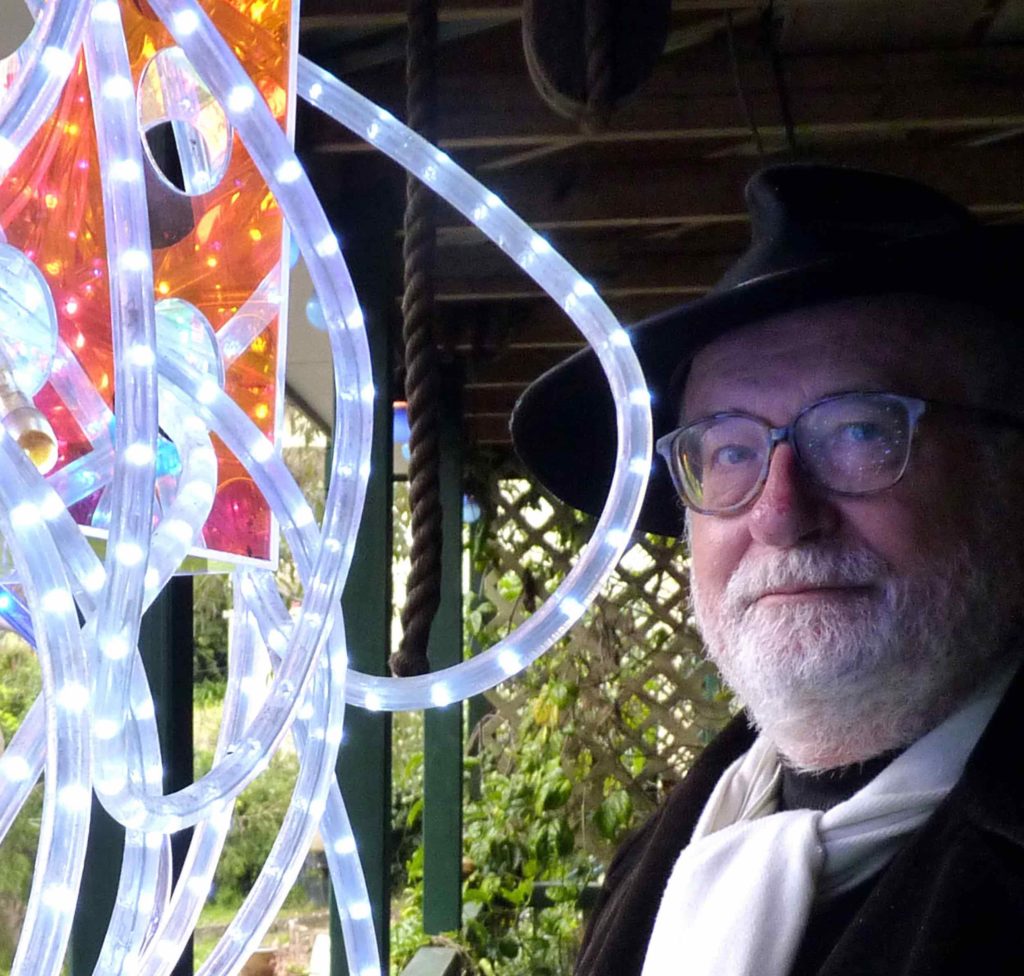
MT: Where did the business name Ellis D. Fogg come from?
RF: My nickname at school was Fogg. I suppose it derived from my ethereal way of pondering things. LSD was legal in Australia until 1969. The name would represent a collective. It’s not just about me. People would come up after the shows and want to meet Mr Fogg. I’d sometimes say that was my father and he’s gone home to watch the telly.
MT: Who were you collaborators?
RF: Eddie Van Der Madden was the master of the wet show and brilliant at building effects projectors. Graham Beatty was and still is the best man in the world for building a lighting effect from scratch. His walls of light were out there well before the big shows rolled into town.
Then there’s Peter Lockwood who’s at the Opera House now, Peter Howard who kept all the film and slide material in order, Ray Medhurst, Steve Devine who invented the winch ups Phil Salmon and Richard White from Rock Industries would later build for me, Tiny Goode, Mark Howard, Ian Mac Conachie, Geoff Rose that talented laser man with all the crystals held in place with toothpaste, Barrie Kosky the renowned director and Bruce Jackson and Phil Storey who built the first 3 channel colour organ to my specifications.
MT: Did you coin the phrase JANDS?
RF: They had this complicated name ‘J and S Research Electronics’ for a business building chasers and strobes. I just used to write ‘JandS’ on the cheques and told them to register it.
MT: What do you think of lighting technology today?
RF: Well when the VariLites hit the market they were the be all and end all. Almost. They weren’t as bright as my 35mm carbon arc projector mounted on a Miller tripod head and JANDS asked me to turn down my fluro array one night at a Mardi Gras because it was washing out the VLs. The VL operators were a cocky bunch but Mark Hammer and I turned out some great work together.
MT: What’s not good about the industry?
RF: These travel agents who became ‘event directors’. People think I’m arrogant but I’m just trying to rid my life of idiots. I don’t deal well with Bimbos, male or female. People who are the best at talking are the worst at doing. They talk to justify their stupidity.
One night this event director came up to me and asked if all the audience would be able to see the projections on the clouds. “If we have clouds tonight they will” I said. “Well how does Batman do it?” She demanded. They even have training schools for these idiots incapable of differentiating between fantasy and reality.
MT: You’ve just picked up another 5 year contract on the Christmas tree in Darling Harbour. When did you do the first one?
RF: 1993. Our tree is a wonderful thing from many aspects. Firstly it is a very Australian type tree. It has its own form of translucency, of Lightness and at the same time it’s complex. It’s not homogenous. It looks as good in the early morning with the sun lighting it as it does at night when it lights up. Standing back at distances from it provides different interpretations of the piece.
MT: Highlights over the decades, Roger?
RF: Well the ‘60s were about the shows with Wendy Saddinton, Jeff Duff, Jeff St John and Jeanie Lewis at the Elizabethan Theatre in Newtown. Bill Eliades used to run it. Bill’s done well with the Enmore, Metro and Factory. During the ‘60s three things emerged: the Summer of Love on the USA West Coast; Andy Warhol and Lou Reed in the East; and my awareness of Mahatma Ghandi’s India.
The shows in the Yellow House in the ‘70s were extraordinary. The Yellow House was an artists’ collective filled with creative types and our imagination ran wild. Maggie Tabberer’s productions and the wild times with Chris and Pixie Skase opening the two Mirage resorts (Gold Coast and Port Douglas) were the ‘80s.
Our best show was for Paul Keating, the then PM, just before the election in 1993. Keating was facing a landslide against him and felt internally defeated. We rallied the arts community and created a show which so reinvigorated him that he won against all odds.
Mark, you know the shows you do for nothing just by following your heart are most often the best.
Working with the Gija people from Bow River in 2001 and later the exhibitions in New York showed that you don’t need all the technology to produce a really good show. Just power and light and colour. ‘which tint of white light are you talking about’ I’d ask many times.

MT: 50 years on Roger. What’s the next project for Ellis D. Fogg?
RF: Well I haven’t retired. Far from it. I’d love to design things for some of these younger blokes with lighting gear. I see the same elements, many of them mistakes, repeated endlessly on ‘special’ events. I’m not about keeping it all to myself. There is so much experience here to share and the best way to do that is on the job.
My next show will be in March. There will be 7 artists varying in age from young to old. It will be a retrospective and an astrospective about the past and the future. It will all be tied together with a lightshow, light sculptures and installation pieces.
So there you have it: Roger Foley the creator of Lumino Kinetic Lightshows in the world. 50 years in the business & Roger remains a legend and the Father of AV in Australia.
If you’d like to contact or work with Roger Foley, you’ll find him at fogg@fogg.com.au / www.fogg.com.au
See also ‘Sega World: Sydney’s latest attraction comes to life’, design by Roger Foley, in Connections Magazine, June 1997. [PDF extract 1.3MB]
A ‘History’ extract from CX Magazine – September 2012
LIGHTING | AUDIO | VIDEO | STAGING | INTEGRATION
Entertainment technology news and issues for Australia and New Zealand
– in print and free online www.cxnetwork.com.au
© VCS Creative Publishing
Subscribe
Published monthly since 1991, our famous AV industry magazine is free for download or pay for print. Subscribers also receive CX News, our free weekly email with the latest industry news and jobs.

